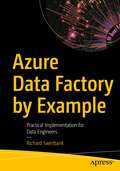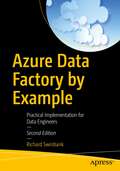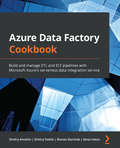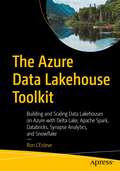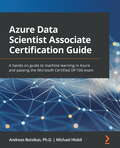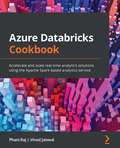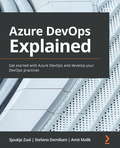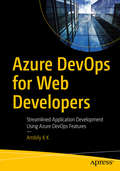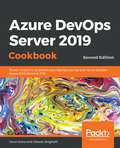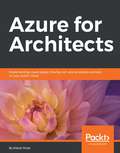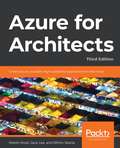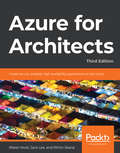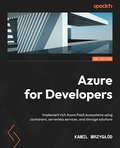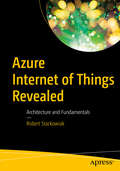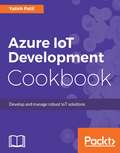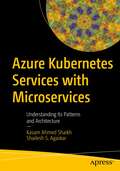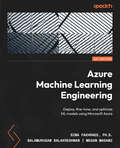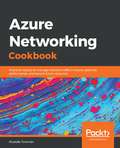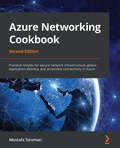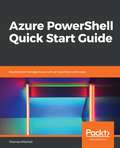- Table View
- List View
Azure Data Factory by Example: Practical Implementation for Data Engineers
by Richard SwinbankData engineers who need to hit the ground running will use this book to build skills in Azure Data Factory v2 (ADF). The tutorial-first approach to ADF taken in this book gets you working from the first chapter, explaining key ideas naturally as you encounter them. From creating your first data factory to building complex, metadata-driven nested pipelines, the book guides you through essential concepts in Microsoft’s cloud-based ETL/ELT platform. It introduces components indispensable for the movement and transformation of data in the cloud. Then it demonstrates the tools necessary to orchestrate, monitor, and manage those components.The hands-on introduction to ADF found in this book is equally well-suited to data engineers embracing their first ETL/ELT toolset as it is to seasoned veterans of Microsoft’s SQL Server Integration Services (SSIS). The example-driven approach leads you through ADF pipeline construction from the ground up, introducing important ideas and making learning natural and engaging. SSIS users will find concepts with familiar parallels, while ADF-first readers will quickly master those concepts through the book’s steady building up of knowledge in successive chapters. Summaries of key concepts at the end of each chapter provide a ready reference that you can return to again and again.What You Will LearnCreate pipelines, activities, datasets, and linked servicesBuild reusable components using variables, parameters, and expressionsMove data into and around Azure services automaticallyTransform data natively using ADF data flows and Power Query data wranglingMaster flow-of-control and triggers for tightly orchestrated pipeline executionPublish and monitor pipelines easily and with confidenceWho This Book Is ForData engineers and ETL developers taking their first steps in Azure Data Factory, SQL Server Integration Services users making the transition toward doing ETL in Microsoft’s Azure cloud, and SQL Server database administrators involved in data warehousing and ETL operations
Azure Data Factory Cookbook: Build and manage ETL and ELT pipelines with Microsoft Azure's serverless data integration service
by Dmitry Anoshin Dmitry Foshin Roman Storchak Xenia IretonSolve real-world data problems and create data-driven workflows for easy data movement and processing at scale with Azure Data FactoryKey FeaturesLearn how to load and transform data from various sources, both on-premises and on cloudUse Azure Data Factory's visual environment to build and manage hybrid ETL pipelinesDiscover how to prepare, transform, process, and enrich data to generate key insightsBook DescriptionAzure Data Factory (ADF) is a modern data integration tool available on Microsoft Azure. This Azure Data Factory Cookbook helps you get up and running by showing you how to create and execute your first job in ADF. You'll learn how to branch and chain activities, create custom activities, and schedule pipelines. This book will help you to discover the benefits of cloud data warehousing, Azure Synapse Analytics, and Azure Data Lake Gen2 Storage, which are frequently used for big data analytics. With practical recipes, you'll learn how to actively engage with analytical tools from Azure Data Services and leverage your on-premise infrastructure with cloud-native tools to get relevant business insights. As you advance, you'll be able to integrate the most commonly used Azure Services into ADF and understand how Azure services can be useful in designing ETL pipelines. The book will take you through the common errors that you may encounter while working with ADF and show you how to use the Azure portal to monitor pipelines. You'll also understand error messages and resolve problems in connectors and data flows with the debugging capabilities of ADF. By the end of this book, you'll be able to use ADF as the main ETL and orchestration tool for your data warehouse or data platform projects.What you will learnCreate an orchestration and transformation job in ADFDevelop, execute, and monitor data flows using Azure SynapseCreate big data pipelines using Azure Data Lake and ADFBuild a machine learning app with Apache Spark and ADFMigrate on-premises SSIS jobs to ADFIntegrate ADF with commonly used Azure services such as Azure ML, Azure Logic Apps, and Azure FunctionsRun big data compute jobs within HDInsight and Azure DatabricksCopy data from AWS S3 and Google Cloud Storage to Azure Storage using ADF's built-in connectorsWho this book is forThis book is for ETL developers, data warehouse and ETL architects, software professionals, and anyone who wants to learn about the common and not-so-common challenges faced while developing traditional and hybrid ETL solutions using Microsoft's Azure Data Factory. You'll also find this book useful if you are looking for recipes to improve or enhance your existing ETL pipelines. Basic knowledge of data warehousing is expected.
Azure Data Factory Cookbook: Build ETL, Hybrid ETL, and ELT pipelines using ADF, Synapse Analytics, Fabric and Databricks
by Dmitry Foshin Tonya Chernyshova Dmitry Anoshin Xenia IretonData Engineers guide to solve real-world problems encountered while building and transforming data pipelines using Azure's data integration toolKey FeaturesSolve real-world data problems and create data-driven workflows with ease using Azure Data FactoryBuild an ADF pipeline that operates on pre-built ML model and Azure AIGet up and running with Fabric Data Explorer and extend ADF with Logic Apps and Azure functionsBook DescriptionThis new edition of the Azure Data Factory book, fully updated to reflect ADS V2, will help you get up and running by showing you how to create and execute your first job in ADF. There are updated and new recipes throughout the book based on developments happening in Azure Synapse, Deployment with Azure DevOps, and Azure Purview. The current edition also runs you through Fabric Data Factory, Data Explorer, and some industry-grade best practices with specific chapters on each. You’ll learn how to branch and chain activities, create custom activities, and schedule pipelines, as well as discover the benefits of cloud data warehousing, Azure Synapse Analytics, and Azure Data Lake Gen2 Storage. With practical recipes, you’ll learn how to actively engage with analytical tools from Azure Data Services and leverage your on-premises infrastructure with cloud-native tools to get relevant business insights. You'll familiarize yourself with the common errors that you may encounter while working with ADF and find out the solutions to them. You’ll also understand error messages and resolve problems in connectors and data flows with the debugging capabilities of ADF. By the end of this book, you’ll be able to use ADF with its latest advancements as the main ETL and orchestration tool for your data warehouse projects.What you will learnBuild and Manage data pipelines with ease using the latest version of ADFConfigure, load data, and operate data flows with Azure SynapseGet up and running with Fabric Data FactoryWorking with Azure Data Factory and Azure PurviewCreate big data pipelines using Databricks and Delta tablesIntegrate ADF with commonly used Azure services such as Azure ML, Azure Logic Apps, and Azure FunctionsLearn industry-grade best practices for using Azure Data FactoryWho this book is forThis book is for ETL developers, data warehouse and ETL architects, software professionals, and anyone else who wants to learn about the common and not-so-common challenges faced while developing traditional and hybrid ETL solutions using Microsoft's Azure Data Factory. You’ll also find this book useful if you are looking for recipes to improve or enhance your existing ETL pipelines. Basic knowledge of data warehousing is a prerequisite.
The Azure Data Lakehouse Toolkit: Building and Scaling Data Lakehouses on Azure with Delta Lake, Apache Spark, Databricks, Synapse Analytics, and Snowflake
by Ron L'EsteveDesign and implement a modern data lakehouse on the Azure Data Platform using Delta Lake, Apache Spark, Azure Databricks, Azure Synapse Analytics, and Snowflake. This book teaches you the intricate details of the Data Lakehouse Paradigm and how to efficiently design a cloud-based data lakehouse using highly performant and cutting-edge Apache Spark capabilities using Azure Databricks, Azure Synapse Analytics, and Snowflake. You will learn to write efficient PySpark code for batch and streaming ELT jobs on Azure. And you will follow along with practical, scenario-based examples showing how to apply the capabilities of Delta Lake and Apache Spark to optimize performance, and secure, share, and manage a high volume, high velocity, and high variety of data in your lakehouse with ease.The patterns of success that you acquire from reading this book will help you hone your skills to build high-performing and scalable ACID-compliant lakehouses using flexible and cost-efficient decoupled storage and compute capabilities. Extensive coverage of Delta Lake ensures that you are aware of and can benefit from all that this new, open source storage layer can offer. In addition to the deep examples on Databricks in the book, there is coverage of alternative platforms such as Synapse Analytics and Snowflake so that you can make the right platform choice for your needs.After reading this book, you will be able to implement Delta Lake capabilities, including Schema Evolution, Change Feed, Live Tables, Sharing, and Clones to enable better business intelligence and advanced analytics on your data within the Azure Data Platform.What You Will LearnImplement the Data Lakehouse Paradigm on Microsoft’s Azure cloud platformBenefit from the new Delta Lake open-source storage layer for data lakehouses Take advantage of schema evolution, change feeds, live tables, and moreWrite functional PySpark code for data lakehouse ELT jobsOptimize Apache Spark performance through partitioning, indexing, and other tuning optionsChoose between alternatives such as Databricks, Synapse Analytics, and SnowflakeWho This Book Is ForData, analytics, and AI professionals at all levels, including data architect and data engineer practitioners. Also for data professionals seeking patterns of success by which to remain relevant as they learn to build scalable data lakehouses for their organizations and customers who are migrating into the modern Azure Data Platform.
Azure Data Scientist Associate Certification Guide: A Hands-on Guide To Developing Machine Learning Skills And Passing The Microsoft Certified Dp-100 Exam
by Andreas Botsikas, Ph.D. and Michael HlobilA hands-on guide to machine learning in Azure and passing the Microsoft Certified DP-100 exam
Azure Databricks Cookbook (PDF): Accelerate And Scale Real-time Analytics Solutions Using The Apache Spark-based Analytics Service
by Phani Raj Vinod JaiswalGet to grips with building and productionizing end-to-end big data solutions in Azure and learn best practices for working with large datasets Key Features Integrate with Azure Synapse Analytics, Cosmos DB, and Azure HDInsight Kafka Cluster to scale and analyze your projects and build pipelines Use Databricks SQL to run ad hoc queries on your data lake and create dashboards Productionize a solution using CI/CD for deploying notebooks and Azure Databricks Service to various environments Book Description Azure Databricks is a unified collaborative platform for performing scalable analytics in an interactive environment. The Azure Databricks Cookbook provides recipes to get hands-on with the analytics process, including ingesting data from various batch and streaming sources and building a modern data warehouse. The book starts by teaching you how to create an Azure Databricks instance within the Azure portal, Azure CLI, and ARM templates. You'll work through clusters in Databricks and explore recipes for ingesting data from sources, including files, databases, and streaming sources such as Apache Kafka and EventHub. The book will help you explore all the features supported by Azure Databricks for building powerful end-to-end data pipelines. You'll also find out how to build a modern data warehouse by using Delta tables and Azure Synapse Analytics. Later, you'll learn how to write ad hoc queries and extract meaningful insights from the data lake by creating visualizations and dashboards with Databricks SQL. Finally, you'll deploy and productionize a data pipeline as well as deploy notebooks and Azure Databricks service using continuous integration and continuous delivery (CI/CD). By the end of this Azure book, you'll be able to use Azure Databricks to streamline different processes involved in building data-driven apps. What you will learn Read and write data from and to various Azure resources and file formats Build a modern data warehouse with Delta Tables and Azure Synapse Analytics Explore jobs, stages, and tasks and see how Spark lazy evaluation works Handle concurrent transactions and learn performance optimization in Delta tables Learn Databricks SQL and create real-time dashboards in Databricks SQL Integrate Azure DevOps for version control, deploying, and productionizing solutions with CI/CD pipelines Discover how to use RBAC and ACLs to restrict data access Build end-to-end data processing pipeline for near real-time data analytics Who this book is for This recipe-based book is for data scientists, data engineers, big data professionals, and machine learning engineers who want to perform data analytics on their applications. Prior experience of working with Apache Spark and Azure is necessary to get the most out of this book.
Azure DevOps Explained: Get started with Azure DevOps and develop your DevOps practices
by Amit Malik Stefano Demiliani Sjoukje ZaalImplement real-world DevOps and cloud deployment scenarios using Azure Repos, Azure Pipelines, and other Azure DevOps toolsKey FeaturesImprove your application development life cycle with Azure DevOps in a step-by-step mannerApply continuous integration and continuous deployment to reduce application downtimeWork with real-world CI/CD scenarios curated by a team of renowned Microsoft MVPs and MCTsBook DescriptionDeveloping applications for the cloud involves changing development methodologies and procedures. Continuous integration and continuous deployment (CI/CD) processes are a must today, but are often difficult to implement and adopt. Azure DevOps is a Microsoft Azure cloud service that enhances your application development life cycle and enables DevOps capabilities. Starting with a comprehensive product overview, this book helps you to understand Azure DevOps and apply DevOps techniques to your development projects. You'll find out how to adopt DevOps techniques for your development processes by using built-in Azure DevOps tools. Throughout the course of this book, you'll also discover how to manage a project with the help of project management techniques such as Agile and Scrum, and then progress toward development aspects such as source code management, build pipelines, code testing and artifacts, release pipelines, and GitHub integration. As you learn how to implement DevOps practices, this book will also provide you with real-world examples and scenarios of DevOps adoption. By the end of this DevOps book, you will have learned how to adopt and implement Azure DevOps features in your real-world development processes.What you will learnGet to grips with Azure DevOpsFind out about project management with Azure BoardsUnderstand source code management with Azure ReposBuild and release pipelinesRun quality tests in build pipelinesUse artifacts and integrate Azure DevOps in the GitHub flowDiscover real-world CI/CD scenarios with Azure DevOpsWho this book is forThis book is for developers, solutions architects, and DevOps engineers interested in getting started with cloud DevOps practices on Azure. Prior understanding of Azure architecture and services is necessary. Some knowledge of DevOps principles and techniques will be useful.
Azure DevOps for Web Developers: Streamlined Application Development Using Azure DevOps Features
by Ambily K KExplore the architecture, product offerings, and the various stages of implementation processes in Azure DevOps. The book starts with the basic concepts of DevOps and moves on to discuss project management in Azure DevOps. Next, you will learn requirement management and version control in DevOps. Along the way, you will go through test management followed by continuous integration and build automation with more details on code quality and security implementations. Moving forward, you will learn release pipeline and infrastructure as code implementation including ARM-based environment provisioning and execution. Finally, you’ll cover DevOps architecture blueprints used for deploying your web applications to different platforms . After reading this book, you will be able to understand each stage of Azure DevOps and master its implementation. What You Will Learn Understand the various concepts of Azure DevOps Apply DevOps concepts in a variety of application contexts including web applications, containers, and database Understand the implementation of end-to-end DevOps in Azure Work with the different DevOps design patterns and architectures in Azure Who Is This Book For:Developers and architects working with Azure.
Azure DevOps Server 2019 Cookbook, Second Edition: Proven Recipes To Accelerate Your Devops Journey With Azure Devops Server 2019 (formerly Tfs), 2nd Edition
by Tarun AroraAzure DevOps Server (previously known as TFS) allows you to work in the cloud or on-premises using Azure DevOps Services. This book will help you iteratively develop high quality secure software using Agile techniques. You will also learn to develop your own extensions and release them to millions of developers in the Visual Studio Marketplace.
Azure for Architects
by Ritesh ModiYour one stop guide to making the most out of Azure Cloud About This Book • Get familiar with the different design patterns available in Microsoft Azure • Develop Azure cloud architecture and a pipeline management system • Get to know the security best practices for your Azure deployment Who This Book Is For If you are Cloud Architects, DevOps Engineers, or developers who want to learn key architectural aspects of the Azure Cloud platform, then this book is for you. Prior basic knowledge of the Azure Cloud platform is good to have. What You Will Learn • Familiarize yourself with the components of the Azure Cloud platform • Understand the cloud design patterns • Use enterprise security guidelines for your Azure deployment • Design and implement Serverless solutions • See Cloud architecture and the deployment pipeline • Understand cost management for Azure solutions In Detail Over the years, Azure cloud services has grown quickly, and the number of organizations adopting Azure for their cloud services is also gradually increasing. Leading industry giants are finding that Azure fulfills their extensive cloud requirements. This book will guide you through all the important and tough decision-making aspects involved in architecturing a Azure public cloud for your organization. The book starts with an extensive introduction to all the categories of designs available with Azure. These design patterns focus on different aspects of cloud such as high availability, data management, and so on. Gradually, we move on to various aspects such as building your cloud structure and architecture. It will also include a brief description about different types of services provided by Azure, such as Azure functions and Azure Analytics, which can prove beneficial for an organization. This book will cover each and every aspect and function required to develop a Azure cloud based on your organizational requirements. By the end of this book, you will be in a position to develop a full-fledged Azure cloud. Style and approach This hands-on guide to the Azure Cloud platform covers different architectural concepts and implementations necessary for any enterprise scale deployment.
Azure For Architects: Create Secure, Scalable, High-availability Applications On The Cloud
by Ritesh Modi Jack Lee Rithin SkariaThanks to its support for high availability, scalability, security, performance, and disaster recovery, Azure has been widely adopted to create and deploy different types of application with ease. Updated for the latest developments, this third edition of Azure for Architects helps you get to grips with the core concepts of designing serverless architecture, including containers, Kubernetes deployments, and big data solutions. You'll learn how to architect solutions such as serverless functions, you'll discover deployment patterns for containers and Kubernetes, and you'll explore large-scale big data processing using Spark and Databricks. As you advance, you'll implement DevOps using Azure DevOps, work with intelligent solutions using Azure Cognitive Services, and integrate security, high availability, and scalability into each solution. Finally, you'll delve into Azure security concepts such as OAuth, OpenConnect, and managed identities. By the end of this book, you'll have gained the confidence to design intelligent Azure solutions based on containers and serverless functions.
Azure for Architects: Create secure, scalable, high-availability applications on the cloud
by Ritesh Modi Jack Lee Rithin SkariaBuild and design multiple types of applications that are cross-language, platform, and cost-effective by understanding core Azure principles and foundational concepts Key Features Get familiar with the different design patterns available in Microsoft Azure Develop Azure cloud architecture and a pipeline management system Get to know the security best practices for your Azure deployment Book Description Thanks to its support for high availability, scalability, security, performance, and disaster recovery, Azure has been widely adopted to create and deploy different types of application with ease. Updated for the latest developments, this third edition of Azure for Architects helps you get to grips with the core concepts of designing serverless architecture, including containers, Kubernetes deployments, and big data solutions. You'll learn how to architect solutions such as serverless functions, you'll discover deployment patterns for containers and Kubernetes, and you'll explore large-scale big data processing using Spark and Databricks. As you advance, you'll implement DevOps using Azure DevOps, work with intelligent solutions using Azure Cognitive Services, and integrate security, high availability, and scalability into each solution. Finally, you'll delve into Azure security concepts such as OAuth, OpenConnect, and managed identities. By the end of this book, you'll have gained the confidence to design intelligent Azure solutions based on containers and serverless functions. What you will learn Understand the components of the Azure cloud platform Use cloud design patterns Use enterprise security guidelines for your Azure deployment Design and implement serverless and integration solutions Build efficient data solutions on Azure Understand container services on Azure Who this book is for If you are a cloud architect, DevOps engineer, or a developer looking to learn about the key architectural aspects of the Azure cloud platform, this book is for you. A basic understanding of the Azure cloud platform will help you grasp the concepts covered in this book more effectively.
Azure for Decision Makers: The essential guide to Azure for business leaders
by Jack Lee Jason Milgram David RendónDevelop expertise in Azure to plan, guide, and lead a streamlined modernization processKey FeaturesExplore core Azure infrastructure technologies and solutionsAchieve smooth app migration and modernization goals with cloud designMaster Azure architecture and adopt it to scale your business globallyPurchase of the print or Kindle book includes a free PDF eBookBook DescriptionAzure for Decision Makers provides a comprehensive overview of the latest updates in cloud security, hybrid cloud and multi-cloud solutions, and cloud migration in Azure. This book is a must-have introduction to the Microsoft Azure cloud platform, demonstrating the substantial scope of digital transformation and innovation that can be achieved with Azure's capabilities. The first set of chapters will get you up to speed with Microsoft Azure's evolution before showing you how to integrate it into your existing IT infrastructure. Next, you’ll gain practical insights into application migration and modernization, focusing mainly on migration planning, implementation, and best practices. Throughout the book, you’ll get the information you need to spearhead a smooth migration and modernization process, detailing Azure infrastructure as a service (IaaS) deployment, infrastructure management, and key application architectures. The concluding chapters will help you to identify and incorporate best practices for cost optimization and management, Azure DevOps, and Azure automation. By the end of this book, you’ll have learned how to lead end-to-end Azure operations for your organization and effectively cost-optimize your processes ─ from the planning and cloud migration stage through to troubleshooting.What you will learnFind out how to optimize business costs with AzureStrategize the migration of applications to the cloud with AzureSmooth out the deployment and running of Azure infrastructure servicesEffectively define roles, responsibilities, and governance frameworks in DevOpsMaximize the utility of Azure security fundamentals and best practicesAdopt best practices to make the most of your Azure deploymentWho this book is forAzure for Decision Makers is for business and IT decision makers who want to choose the right technology solutions for their businesses and optimize their management processes. It’ll help you develop expertise in operating and administering the Azure cloud. This book will also be useful for CIOs and CTOs looking to understand more about how IT can make their business infrastructure more efficient and easier to use, which will reduce friction within their organization. Knowledge of Azure is helpful, but not necessary to get the most out of this guide.
Azure For Developers: Implementing Rich Azure Paas Ecosystems Using Containers, Serverless Services And Storage Solutions
by Kamil MrzygódImplement rich Azure PaaS ecosystems using containers, serverless services, and storage solutions
Azure Integration Guide for Business: Master effective architecture strategies for business innovation
by Joshua Garverick Jack Lee Mélony Qin Trevoir WilliamsLeverage the cloud to optimize costs, improve security, and seamlessly scale your business operationsKey FeaturesAchieve your operational goals with Azure infrastructureOptimize costs with serverless event-driven solutions through Azure cloud patternsBoost productivity with Azure architecture’s flexibility and scalabilityPurchase of the print or Kindle book includes a free PDF eBookBook DescriptionAzure Integration Guide for Business is essential for decision makers planning to transform their business with Microsoft Azure. The Microsoft Azure cloud platform can improve the availability, scalability, and cost-efficiency of any business. The guidance in this book will help decision makers gain valuable insights into proactively managing their applications and infrastructure. You'll learn to apply best practices in Azure Virtual Network and Azure Storage design, ensuring an efficient and secure cloud infrastructure. You'll also discover how to automate Azure through Infrastructure as Code (IaC) and leverage various Azure services to support OLTP applications. Next, you’ll explore how to implement Azure offerings for event-driven architectural solutions and serverless applications. Additionally, you’ll gain in-depth knowledge on how to develop an automated, secure, and scalable solutions. Core elements of the Azure ecosystem will be discussed in the final chapters of the book, such as big data solutions, cost governance, and best practices to help you optimize your business. By the end of this book, you’ll understand what a well-architected Azure solution looks like and how to lead your organization toward a tailored Azure solution that meets your business needs.What you will learnOptimize the performance and costs with AzureSelect an effective, scalable, and flexible solution that aligns with your needsHarness the power of containers to drive your application development and deploymentCreate big data solutions with the best Azure tools, platforms, and resourcesExplore the benefits of automation for enhanced productivityImprove the availability and effectiveness of monitoring with AzureWho this book is forThis book is for business decision makers looking to benefit from the flexibility, scalability, and optimized costs offered by Microsoft Azure to scale their businesses. Basic knowledge of Azure is recommended to get the most out of this book.
Azure Internet of Things Revealed: Architecture and Fundamentals
by Robert StackowiakDesign, build, and justify an optimal Microsoft IoT footprint to meet your project needs. This book describes common Internet of Things components and architecture and then focuses on Microsoft’s Azure components relevant in deploying these solutions.Microsoft-specific topics addressed include: deploying edge devices and pushing intelligence to the edge; connecting IoT devices to Azure and landing data there, applying Azure Machine Learning, analytics, and Cognitive Services; roles for Microsoft solution accelerators and managed solutions; and integration of the Azure footprint with legacy infrastructure.The book concludes with a discussion of best practices in defining and developing solutions and creating a plan for success.What You Will LearnDesign the right IoT architecture to deliver solutions for a variety of project needsConnect IoT devices to Azure for data collection and delivery of servicesUse Azure Machine Learning and Cognitive Services to deliver intelligence in cloud-based solutions and at the edgeUnderstand the benefits and tradeoffs of Microsoft's solution accelerators and managed solutionsInvestigate new use cases that are described and apply best practices in deployment strategiesIntegrate cutting-edge Azure deployments with existing legacy data sourcesWho This Book Is ForDevelopers and architects new to IoT projects or new to Microsoft Azure IoT components as well as readers interested in best practices used in architecting IoT solutions that utilize the Azure platform
Azure IoT Development Cookbook
by Yatish PatilOver 50 recipes to drive IoT innovation with Microsoft Azure About This Book • Build secure and scalable IoT solutions with Azure IoT platform • Learn techniques to build end to end IoT solutions leveraging the Azure IoT platform • Filled with practical recipes to help you increase connectivity and automation across IoT devices Who This Book Is For If you are an application developer and want to build robust and secure IoT solution for your organization using Azure IoT, then this book is for you. What You Will Learn • Build IoT Solutions using Azure IoT & Services • Learn device configuration and communication protocols • Understand IoT Suite and Pre-configured solutions • Manage Secure Device communications • Understand Device management, alerts • Introduction with IoT Analytics, reference IoT Architectures • Reference Architectures from Industry • Pre-Configured IoT Suite solutions In Detail Microsoft's end-to-end IoT platform is the most complete IoT offering, empowering enterprises to build and realize value from IoT solutions efficiently. It is important to develop robust and reliable solutions for your organization to leverage IoT services. This book focuses on how to start building custom solutions using the IoT hub or the preconfigured solution of Azure IoT suite. As a developer, you will be taught how to connect multiple devices to the Azure IoT hub, develop, manage the IoT hub service and integrate the hub with cloud. We will be covering REST APIs along with HTTP, MQTT and AMQP protocols. It also helps you learn Pre-Configured IoT Suite solution. Moving ahead we will be covering topics like:-Process device-to-cloud messages and cloud-to-device messages using .Net-Direct methods and device management-Query Language, Azure IoT SDK for .Net-Creating and managing, Securing IoT hub, IoT Suite and many more. We will be using windows 10 IoT core, Visual Studio, universal Windows platform. At the end, we will take you through IoT analytics and provide a demo of connecting real device with Azure IoT. Style and approach A set of exciting recipes of using Microsoft Azure IoT more effectively.
The Azure IoT Handbook: Develop IoT solutions using the intelligent edge-to-cloud technologies
by Dan ClarkThe essential guide to architecting Azure IoT systems—from provisioning and monitoring IoT sensors to analyzing real-time streaming dataKey FeaturesDevelop a complete IoT system in Azure with the help of hands-on examplesDiscover how to create, secure, and manage an enterprise-wide IoT systemLearn how to collect, analyze, and visualize streaming dataPurchase of the print or Kindle book includes a free PDF eBookBook DescriptionWith the rise of cloud-based computing, deploying IoT systems has become more cost-effective for businesses. This transformation has led to developers and architects shouldering the responsibility of creating, managing, and securing these systems, even if they are new to the IoT technology. The Azure IoT Handbook is a comprehensive introduction to quickly bring you up to speed in this rapidly evolving landscape. Starting with the basic building blocks of any IoT system, this book guides you through mobile device management and data collection using an IoT hub. You’ll explore essential tools for system security and monitoring. Following data collection, you’ll delve into real-time data analytics using Azure Stream Analytics and view real-time streaming on a Power BI dashboard. Packed with real-world examples, this book covers common IoT use as well. By the end of this IoT book, you’ll know how to design and develop IoT solutions leveraging intelligent edge-to-cloud technologies implemented on Azure.What you will learnGet to grips with setting up and deploying IoT devices at scaleUse Azure IoT Hub for device management and message routingExplore Azure services for analyzing streaming dataUncover effective techniques for visualizing real-time streaming dataDelve into the essentials of monitoring and logging to secure your IoT systemGain insights into real-time analytics with Power BICreate workflows and alerts triggered by streaming dataWho this book is forThe Azure IoT Handbook is for cloud developers and architects who want to learn how to establish an IoT solution on the Azure platform. This book is equally valuable for IoT developers transitioning to Azure, encompassing tasks such as aggregating, analyzing, and visualizing real-time data streams. Basic knowledge of the C# and Python programming languages, as well as a practical understanding of data processing will help you make the most of this book. Familiarity with working with cloud-based services is also advantageous.
Azure Kubernetes Services with Microservices: Understanding Its Patterns and Architecture
by Kasam Ahmed Shaikh Shailesh S. AgaskarDesign and implement scalable microservices using Azure Kubernetes Services (AKS) and other Azure Services. This book will help you understand why and when to choose microservices as a solution for modernization and how to use Azure DevOps to implement CI/CD for deploying microservices. The book starts with an introduction to the evolution to microservices and AKS along with its components. You will learn design patterns to implement microservices on AKS and understand Kubernetes as a container orchestration platform. You will go through the common errors faced in AKS-based applications and ways to handle them. You will learn error handling tips and tricks and how to design for business continuity and disaster recovery. The book discusses things you should know related to security and monitoring when working with AKS-based applications. The book presents a practical approach to set up processes for CI/CD, such as building Build and release pipelines for AKS deployment using Azure DevOps. After reading this book, you will understand design considerations for designing scalable microservices and know how to implement the design through AKS. What You Will LearnKnow design patterns for microservices and how to handle failure scenariosBe aware of architecture and design considerationsUnderstand container and Kubernetes architecture componentsUnderstand security and monitoring aspectsTake a practical approach to continuous integration and continuous deliveryWho This Book Is ForIT professionals associated with cloud computing, especially with Microsoft Azure
Azure Machine Learning Engineering: Deploy, Fine-tune, And Optimize Ml Models Using Microsoft Azure
by Sina Fakhraee Balamurugan Balakreshnan Megan MasanzAzure Machine Learning Engineering: Deploy, Fine-tune, And Optimize Ml Models Using Microsoft Azure
by Sina Fakhraee, Ph.D., Balamurugan Balakreshnan, Megan MasanzDeploy, fine-tune, and optimize ML models using Microsoft Azure
Azure Networking Cookbook: Practical Recipes To Manage Network Traffic In Azure, Optimize Performance, And Secure Azure Resources
by Mustafa ToromanAzure offers an extensive stack of network services that we can use, from simple Virtual Network and Subnets, over Network Security Groups and Gateways, to Load Balancers and many other services. In this book, we’ll offer the best Azure networking recipes to help you quickly create network resources and use them to your advantage.
Azure Networking Cookbook: Practical recipes for secure network infrastructure, global application delivery, and accessible connectivity in Azure
by Mustafa ToromanLearn to leverage virtual machines and load balancers to facilitate secure and efficient networking.Key FeaturesImproved and updated with the latest networking features and additions in Microsoft AzureUpgrade your cloud networking skills by planning, implementing, configuring, and securing your infrastructure network with AzureLeverage Azure networking services to provide applications highly available and fault-tolerant environmentBook DescriptionAzure's networking services enable organizations to manage their networks effectively. Azure paves the way for an enterprise to achieve reliable performance and secure connectivity.Azure Networking Cookbook, Second Edition starts with an introduction to Azure networking, covering basic steps such as creating Azure virtual networks, designing address spaces, and creating subnets. You will go on to learn how to create and manage network security groups, application security groups, and IP addresses in Azure. As you progress, you will explore various aspects such as Site-to-Site, Point-to-Site, and virtual network–to–virtual network connections, DNS and routing, load balancers, and Traffic Manager. This cookbook covers every aspect and function you need to be aware of, providing practical recipes to help you go from having a basic understanding of cloud networking practices to being able to plan, implement, and secure your network infrastructure with Azure. This cookbook will not only help you upscale your current environment but also instruct you on how to monitor, diagnose, and ensure secure connectivity. After learning how to create a robust environment, you will gain meaningful insights from recipes on best practices.By the end of this cookbook, you will possess sufficient practical experience in providing cost-effective solutions to facilitate efficient connectivity in your organization.What you will learnCreate Azure networking servicesUnderstand how to create and work on hybrid connectionsConfigure and manage Azure network servicesStudy ways to design high availability network solutions in AzureDiscover how to monitor and troubleshoot Azure network resourcesExplore different methods of connecting local networks to Azure virtual networksWho this book is forThis cookbook is targeted at cloud architects, cloud solution providers, or any stakeholders dealing with networking on Azure. Basic familiarity with Azure would be a plus.
Azure PowerShell Quick Start Guide: Deploy And Manage Azure Virtual Machines With Ease
by Thomas MitchellAs an IT professional, it is important to keep up with cloud technologies and learn to manage those technologies. PowerShell is a critical tool that must be learned in order to effectively and more easily manage many Azure resources. This book is designed to teach you to leverage PowerShell to perform many day-to-day tasks in Microsoft Azure.
